着物姿の印象を大きく左右する帯。中でも「袋帯(ふくろおび)」は、その格調の高さと華やかさで、特別な日の装いを一層引き立てる存在です。しかし、一言で袋帯と言っても、その種類や合わせ方には様々な決まり事や知恵が隠されています。なぜ袋帯は礼装の代表格なのでしょうか?そして、数ある中から自分に最適な一本をどのように選べば良いのでしょうか。
この帯が持つ豊かな物語を知ることは、着物文化の奥深さに触れる旅の始まりでもあります。
- 軽量化が生んだ格式: 重厚な丸帯から、より実用性と美を追求して誕生した歴史的背景。
- 柄付けに隠された意味: 「全通」「六通」「お太鼓柄」それぞれの特徴と、TPOに応じた賢い選び方。
- 祝福を重ねる結びの心: 祝いの席で多用される「二重太鼓結び」に込められた、縁起の良い願い。
丸帯からの進化、袋帯の誕生秘話
着物の帯と聞けば、多くの人が豪華な袋帯を思い浮かべるかもしれません。しかし、その歴史は意外にも新しく、大正時代末期から昭和初期にかけて誕生しました。それ以前の礼装用の帯の主役は「丸帯(まるおび)」でした。
丸帯は、広幅の生地を二つに折って仕立てるため、表も裏も同じ柄が現れる非常に豪華で重厚な帯です。しかしその分、重くて締めにくいという欠点がありました。そこで、**「もっと軽くて扱いやすい礼装用の帯を」**というニーズから考案されたのが袋帯です。
袋帯は、表地と裏地を別々の生地で作り、袋状に縫い合わせることで軽量化を実現しました。裏地には無地の生地を使うことでコストを抑えつつ、礼装としての品格は保っています。この革新により、袋帯は瞬く間に普及し、丸帯に代わってフォーマルシーンの主役となったのです。現在では、丸帯は花嫁衣裳や舞妓の装いなど、限られた場面でしか見られなくなりました。
多様な種類と格式の見分け方
袋帯は、その仕立て方や柄の入り方によって、いくつかの種類に分けられます。これを知ることで、着物や場面に合わせた適切な帯選びが可能になります。
最も一般的なのは、表地と裏地を縫い合わせた「縫い袋帯」です。対して、筒状に織り上げられた「本袋帯」は、縫い目がないため体に馴染みやすいとされますが、製造に手間がかかるため現在では希少な存在です。
また、柄の入り方にも種類があります。
- 全通柄(ぜんつうがら): 帯全体に柄が入っているもの。どのような結び方をしても柄が出るため非常に豪華ですが、その分高価になります。
- 六通柄(ろくつうがら): 帯の約6割に柄が入っているもの。胴に巻いた時に隠れる部分が無地になっており、現在の袋帯の主流です。
- お太鼓柄(おたいこがら): お太鼓結びをした際に、背中のお太鼓部分と体の前にくる部分だけに柄を配したものです。
金糸や銀糸をふんだんに使った豪華な織りの袋帯は、黒留袖や振袖、訪問着といった格の高い着物に合わせ、結婚式や式典などの晴れやかな席で用いられます。一方で、「しゃれ袋帯」と呼ばれる、金銀糸をあまり使わずに趣味性の高い柄を織り出したものもあり、こちらは小紋や紬などのおしゃれ着に合わせて、少し改まったお出かけの際に活躍します。
祝福の心を形にする二重太鼓結び
袋帯を締める際の最も代表的な結び方が「二重太鼓結び(にじゅうたいこむすび)」です。その名の通り、お太鼓の部分が二重になる結び方で、この「重なる」という点に縁起の良さが込められています。
「喜びが重なりますように」「幸せを重ねる」
そうした願いを込めて、特にお祝いの席で好まれる結び方なのです。この二重太鼓を美しく作るためには、約4m30cm以上という袋帯の長さが必要不可欠です。名古屋帯(長さ約3m60cm前後)が一重太鼓しかできないのと比較すると、その違いは明確です。
振袖の場合は、「ふくら雀」や「立て矢結び」など、さらに華やかで創造的な飾り結びが用いられます。これらの結び方も、袋帯の十分な長さを活かして、若々しい晴れ着姿を一層引き立てます。結び方一つにも、着用する人の立場や場面、そして祝福の心が表現されているのです。
今後の動向と注目点
着物が日常着から特別な日の装いへと変化した現代において、袋帯は日本の伝統的な美意識と職人技術を象徴するアイテムとして、その価値を揺るぎないものにしています。
コーディネートにおいては、着物の地色や柄の中から一色を帯の色と合わせると、統一感のある洗練された装いになるとされています。例えば、淡い色の着物に同系色の帯を合わせれば優しく上品な印象に、濃い色の帯を合わせればすっきりとモダンな印象を与えることができます。
袋帯は、留袖や振袖、訪問着といった格式の高い礼装用の着物に合わせるのが基本です。結婚式や披露宴、格式あるパーティー、お子様の入学式や卒業式といった場面で、その場にふさわしい品格と華やかさを添えてくれます。
解説ポイント①:軽量化が生んだ格式:重厚な丸帯から、より実用性と美を追求して誕生した歴史的背景
袋帯の誕生は、単なる「帯の種類の追加」ではなく、着物を着る人々の価値観の変化を反映した出来事でした。江戸時代から続く「丸帯」は、その重厚さゆえに権威と富の象徴でしたが、同時に身体的な負担も大きいものでした。
大正から昭和へ、生活様式が近代化する中で、着物にもより軽やかさや実用性が求められるようになりました。この流れの中で、丸帯の「重い」「高価」「締めるのが大変」という点を解消すべく、袋帯が開発されました。裏地を無地にすることで、約半分の重さに軽量化され、価格も抑えることが可能になりました。この実用性の向上が、袋帯が急速に普及し、礼装用の帯のスタンダードとなる最大の要因でした。それは、見た目の豪華さだけでなく、着用者の快適性も重視するという、新しい美意識の表れだったと言えるでしょう。
解説ポイント②:柄付けに隠された意味:「全通」「六通」「お太鼓柄」それぞれの特徴と、TPOに応じた賢い選び方
袋帯の柄付けは、見た目の美しさだけでなく、機能性や経済性にも深く関わっています。
- 全通柄: 帯全体に柄があるため、最も格が高いとされます。柄出しを気にする必要がなく、どんな結び方にも対応できる万能さが魅力です。しかし、柄が多い分、糸の使用量も多くなり高価になる傾向があります。
- 六通柄: 現在最も一般的なタイプです。胴に巻くと隠れてしまう一巻き目の部分を無地にすることで、コストを抑えつつ、見た目の豪華さは損なわないという合理的な工夫がされています。初心者でも柄の開始位置が分かりやすく、締めやすいというメリットもあります。
- お太鼓柄: ピンポイントで柄を配置するため、さらに経済的で、デザインの自由度も高まります。古典柄だけでなく、現代的でアーティスティックな柄も多く見られ、個性を表現したい場合に適しています。
このように、どの柄付けを選ぶかは、予算はもちろん、どのような着こなしを目指すか、また着付けのしやすさといった実用的な側面も考慮して判断することが賢明です。
解説ポイント③:祝福を重ねる結びの心:祝いの席で多用される「二重太鼓結び」に込められた、縁起の良い願い
「二重太鼓結び」は、袋帯を象徴する結び方であり、その背景には日本の「言霊(ことだま)」や「縁起を担ぐ」文化が色濃く反映されています。物理的に布が二重になる様子を、**「良い出来事が重なる」**という吉兆と結びつけたのです。
結婚式でこの結び方が定番とされるのは、新郎新婦の末永い幸せが重なり続くように、との願いが込められているからです。同様に、入学式や祝賀会など、様々なお祝いの場面で用いられます。
一方で、弔事の際には「不幸が重なる」ことを避けるため、一重太Katsuyo-musubi(一重太鼓結び)が基本となります。このように、帯の結び方一つが、その場の性質や人々が込める祈りを雄弁に物語る、重要なコミュニケーションツールとしての役割も担っているのです。袋帯と二重太鼓結びの関係は、単なるファッションの様式ではなく、日本の精神文化そのものを映し出す鏡と言えるでしょう。
参考文献
- 袋帯ってどんな帯?袋帯の特徴や着付け、袋帯の選び方までご紹介! – バイセル オンラインストア
- 【着物・帯】袋帯ってどんな帯?いつ締めるの?? – あまのや
- 帯の種類 袋帯の基礎編 帯メーカーが徹底解説!|KAWASHIMA Stories – 川島織物セルコン
- 袋帯の柄にはどのような種類があるの?帯も季節を気にするべき? – 福ちゃん
- 袋帯にも「格」の違いがある?着物に合わせて美しく着こなす方法 – 婦人画報
【English Article】
The Elegant World of the Fukuro Obi: How to Select and Coordinate the Perfect Sash to Elevate Your Kimono Style
The obi, or sash, is a crucial element that dramatically shapes the impression of a kimono ensemble. Among the various types, the “Fukuro Obi” stands out for its high level of formality and splendor, making it an essential component for special occasions. However, the world of the Fukuro Obi is rich with its own set of rules and wisdom regarding its types and coordination. Why is the Fukuro Obi considered the quintessential formal sash? And how does one choose the perfect one from the myriad of options available?
Delving into the rich story of this obi is the first step on a journey into the profound depths of kimono culture.
- Formality Born from Lightness: Its historical evolution from the heavy Maru Obi, in pursuit of greater practicality and beauty.
- The Hidden Meaning in Patterns: Understanding the characteristics of “Zentsu,” “Rokutsu,” and “Otaiko” patterns for smart TPO-based choices.
- A Knot that Multiplies Blessings: The auspicious wishes embedded in the “Nijutaiko Musubi,” a knot frequently used for celebratory occasions.
The Evolution from Maru Obi: The Story Behind the Fukuro Obi’s Birth
When one thinks of a kimono sash, the luxurious Fukuro Obi often comes to mind. However, its history is surprisingly recent, having been created from the late Taisho to the early Showa period (roughly the 1920s-1930s). Before that, the primary formal obi was the “Maru Obi.”
The Maru Obi is an incredibly opulent and heavy sash made by folding a wide piece of brocade in half, resulting in the same pattern appearing on both the front and back. However, its significant drawback was its weight and difficulty in tying. This led to the demand for “a lighter, more manageable formal obi,” which spurred the invention of the Fukuro Obi.
The Fukuro Obi achieved its lighter weight by being constructed like a bag, with the outer fabric and lining made from separate pieces of cloth and sewn together. Using a plain fabric for the lining helped reduce costs while maintaining the sash’s formal dignity. Thanks to this innovation, the Fukuro Obi quickly gained popularity, replacing the Maru Obi as the mainstream choice for formal occasions. Today, the Maru Obi is rarely seen, reserved for specific attire such as bridal gowns and maiko (apprentice geisha) costumes.
Distinguishing Between Various Types and Levels of Formality
Fukuro Obi can be categorized into several types based on their construction and how the pattern is applied. Understanding these differences allows for the appropriate selection of an obi that complements the kimono and suits the occasion.
The most common type is the “Nui-bukuro Obi,” where the outer fabric and lining are sewn together. In contrast, the “Hon-bukuro Obi,” which is woven seamlessly as a tube, is known to conform better to the body but is now rare due to its complex manufacturing process.
The pattern application also varies:
- Zentsu-gara: The pattern covers the entire length of the obi. It is very luxurious as the pattern is visible regardless of how it is tied, but this makes it more expensive.
- Rokutsu-gara: The pattern covers about 60% of the obi’s length. The section that remains hidden when wrapped around the waist is left plain. This is the most common type of Fukuro Obi today.
- Otaiko-gara: The pattern is placed only on the “otaiko” (the drum-like bow on the back) and the section visible on the front.
Luxurious woven Fukuro Obi, lavishly decorated with gold and silver threads, are paired with high-ranking kimono such as Kurotomesode, Furisode, and Homongi for celebratory events like weddings and official ceremonies. On the other hand, there are also “Share-bukuro Obi” (fashionable Fukuro Obi), which use fewer metallic threads and feature more artistic, non-traditional patterns. These are suitable for slightly less formal outings when paired with stylish kimono like Komon or Tsumugi.
The Nijutaiko Musubi: Shaping a Heart of Blessings
The most representative way to tie a Fukuro Obi is the “Nijutaiko Musubi” (double-layer drum knot). As its name suggests, the otaiko part of the knot is formed with two layers. This “layering” is considered auspicious.
“May joy be layered.” “To pile up happiness.”
With such wishes embedded, this knot is especially favored for celebratory events. To create a beautiful Nijutaiko knot, the Fukuro Obi’s length of over 4.3 meters is essential. This is a clear difference from the Nagoya Obi (around 3.6 meters long), which can only be tied in a single-layer drum knot.
For Furisode (long-sleeved kimono for young, unmarried women), even more elaborate and creative knots like the “Fukura Suzume” (plump sparrow) or “Tateya Musubi” (standing arrow) are used. These styles also take advantage of the Fukuro Obi’s ample length to further enhance the youthful splendor of the formal attire. The style of the knot itself speaks volumes about the wearer’s status, the occasion, and the sentiments of celebration.
Future Trends and Points of Interest
In an era where the kimono has transitioned from daily wear to attire for special occasions, the Fukuro Obi stands as an unwavering symbol of traditional Japanese aesthetics and craftsmanship.
In terms of coordination, matching the color of the obi with a color from the kimono’s base or pattern is said to create a unified and sophisticated look. For instance, pairing a light-colored kimono with a similarly toned obi creates a gentle and elegant impression, while a dark-colored obi can produce a sharp, modern feel.
The Fukuro Obi is fundamentally paired with highly formal kimono like Tomesode, Furisode, and Homongi. It adds the appropriate level of dignity and splendor for occasions such as weddings, receptions, prestigious parties, and children’s school entrance or graduation ceremonies.
Analysis Point ①: Formality Born from Lightness: Its historical evolution from the heavy Maru Obi, in pursuit of greater practicality and beauty
The birth of the Fukuro Obi was not merely the addition of a new type of sash; it was a reflection of a shift in the values of kimono wearers. The “Maru Obi,” used since the Edo period, was a symbol of authority and wealth due to its sheer weight and opulence, but it also placed a significant physical burden on the wearer.
As lifestyles modernized from the Taisho to the Showa era, there was a growing demand for lighter and more practical kimono. The Fukuro Obi was developed in response to this trend, addressing the “heavy,” “expensive,” and “difficult to tie” aspects of the Maru Obi. By using a plain lining, its weight was reduced by about half, and it became more affordable. This improvement in practicality was the single biggest factor in its rapid adoption as the standard for formal wear. It signaled the emergence of a new aesthetic that valued not only visual splendor but also the comfort of the wearer.
Analysis Point ②: The Hidden Meaning in Patterns: Understanding the characteristics of “Zentsu,” “Rokutsu,” and “Otaiko” patterns for smart TPO-based choices
The pattern on a Fukuro Obi is deeply connected not only to its beauty but also to its functionality and economic efficiency.
- Zentsu-gara: With a pattern covering the entire length, it is considered the most formal. Its versatility is a key appeal, as one doesn’t need to worry about pattern placement, making it suitable for any tying style. However, the extensive use of thread tends to make it more expensive.
- Rokutsu-gara: This is the most common type today. It is a rational design that keeps costs down without sacrificing the luxurious appearance by leaving the hidden, first wrap around the torso unpatterned. It also has the practical advantage of being easier for beginners to tie, as the starting point of the pattern is clear.
- Otaiko-gara: By placing the pattern only in specific spots, this style is even more economical and allows for greater design freedom. Many feature not just classic motifs but also modern, artistic designs, making them suitable for expressing individuality.
Thus, the choice of pattern should be made by considering not only the budget and desired aesthetic but also practical aspects like the ease of tying.
Analysis Point ③: A Knot that Multiplies Blessings: The auspicious wishes embedded in the “Nijutaiko Musubi,” a knot frequently used for celebratory occasions
The “Nijutaiko Musubi” is the signature knot for the Fukuro Obi, and its background is deeply colored by the Japanese cultural belief in “Kotodama” (the spirit of words) and the practice of seeking good omens. The physical layering of the fabric is symbolically linked to the auspicious idea of “good things piling up.”
This is why the knot is standard at weddings, carrying the wish for the bride and groom’s happiness to multiply and continue. It is similarly used for various other celebrations, such as school entrance ceremonies and commemorative parties.
Conversely, for mourning occasions, a single-layer knot is the norm to avoid the implication of “piling up sorrow.” In this way, the very style of the obi knot serves as a powerful communication tool, eloquently conveying the nature of the event and the prayers of the people involved. The relationship between the Fukuro Obi and the Nijutaiko knot is not just a fashion convention but a mirror reflecting the Japanese spiritual culture itself.
References
- What is a Fukuro Obi? Introducing its characteristics, how to wear it, and how to choose one! – Buysell Online Store
- (Kimono/Obi) What kind of obi is a Fukuro Obi? When do you wear it? – Amanoya
- Types of Obi: Fukuro Obi Basics – A Thorough Explanation by an Obi Maker | KAWASHIMA Stories – Kawashima Selkon Textiles
- What kinds of patterns do Fukuro Obi have? Should you worry about the season for your obi? – Fuku-chan
- Are there differences in the “formality” of Fukuro Obi? How to wear them beautifully with your kimono – Fujingaho


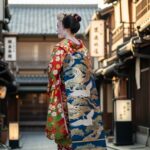

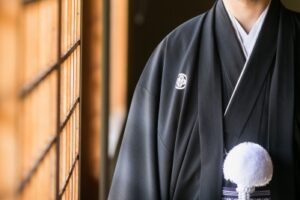

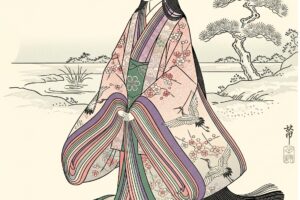
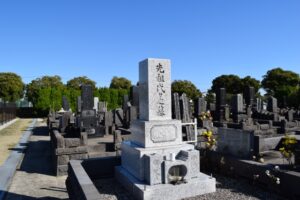
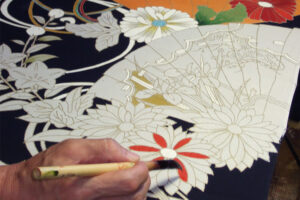
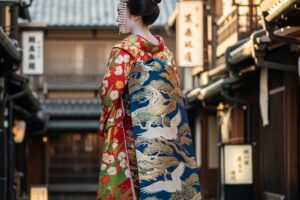

コメントを残す